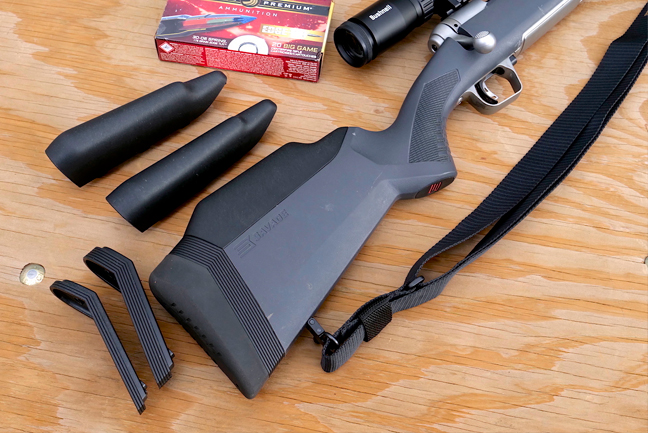- M110 bolt-action Savage rifles with AccuFit stocks are tough, MOA accurate, and inexpensive
- Savage AccuFit rifles adjust to fit 5′ 2″ Betsy and her 5′ 10″ husband
- AccuFit rifles are rough-and-tumble durable
We set sail for Africa with two Savage AccuFit rifles, one in 30-06 Springfield and one in, of all things, 223 Remington. We’ll elaborate on that in later blogs and an upcoming American Hunter magazine. For now, look what those rifles have already accomplished:
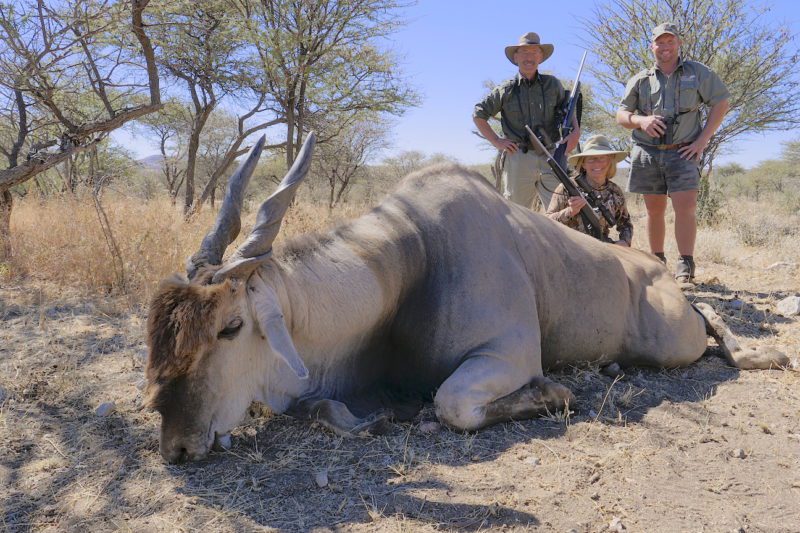
Betsy used a Savage Storm with AccuFit stock in plain Jane 30-06 Springfield firing a Federal Premium load pushing a 180-grain AccuBond bullet 2,700 fps to take this massive eland bull. Werner estimated it’s age at well over 10 years. The thick mop of hair on its forehead, the extensive wear on its horns, and the fact that it was walking all by itself support that. Betsy used Bushnell’s newest Forge scope for a precise aim. Her shot was behind the shoulder, 1/3 of the way up from the brisket. The bull ran 75 yards before collapsing. Anyone who suggests the 30-06 is past its prime hasn’t worked with it enough.
We were still-hunting and had just missed a crack at a small herd of oryx due to thick bush when Werner heard the distinct clicking of a walking eland. The two halves of their heavy hooves slap together audibly when they lift them off the ground. We froze as the gray bull flickered through the thorn brush to emerge in an opening. Betsy made the shot from about 80 yards.
The eland is the world’s largest antelope. The Lord Derby variety is actually larger on average than this more common southern eland, but with mass approaching 2,000 pounds, this bull is big enough for us. After considerable struggle, four of us, a winch, and a farm tractor wrestled it aboard Werner’s Toyota Land Cruiser for the five mile ride to the farm butchery. There a flurry of able hands began reducing it to steaks and roasts that will feed a large staff of farm workers. Game meat that isn’t eaten on the farm is sold to restaurants and supermarkets, just like beef and lamb. My wife and friends Karla and Janelle discovered this while dining at a fine restaurant in Omaruru where they enjoyed giraffe steaks.
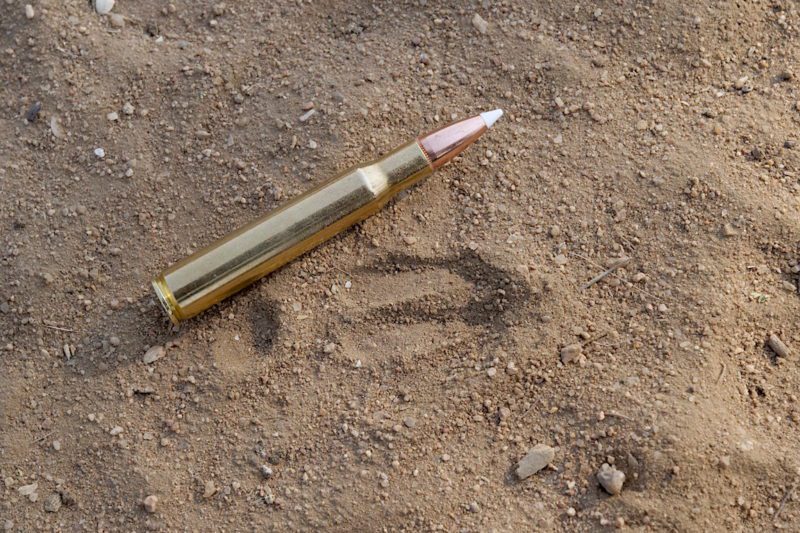
This Federal Premium Fusion cartridge in 223 Remington gives you some idea of the size of a dik dik track. My finger poked the round print behind the track as I laid the cartridge down.
My chance to test the Savage Accufit rifle on game came at the other end of the size spectrum. Instead of the 30-06, I used the 223 Remington. Instead of tackling the world’s largest antelope, I keyed on its smallest — a Damara dik dik. Hunting these territorial little antelope is akin to stalking cottontails in a woodlot back home. We weave slowly through the thorn brush until we spot one of these dainty antelope. Then we use the binoculars to sort hair from horn. Dik dik grow a thick bush of forehead hair that covers most of their tiny horns. Fortunately Werner, who grew up on this Namibian farm, can judge dik dik rams as accurately as he does eland.
“This is an old ram. See how his ears are torn? There, he is marking his territory.”
“I saw that! He poked that twig.” What the ram had done, quick as a wink, was deftly and daintily poke his preorbital gland on a small twig, smearing it with a gummy secretion that tells other rams whose backyard they’ve violated.
“He’s hoping to keep his competitors away, but I don’t think it’s working,” Werner elaborated. “I don’t see a female with him.” Dik dik are almost always seen in pairs, often a female with a kid of the year and the ram nearby. As we tiptoed after this one, we spotted no others. “Either a caracal has caught his partner or she’s run off with a younger, stronger male. This is a good ram to take.”
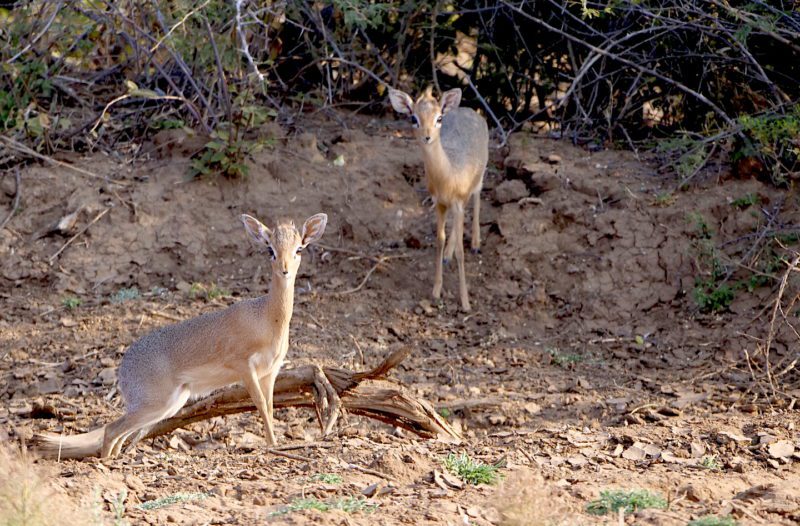
At 10 to 12 pounds, Damara dik dik are one of the world’s smallest antelope. A male and his mate defend a territory against others of their tribe. You can just see the tiny horn tips of the young male in this photo. This is the kind of tiny antelope for which a Savage AccuFit rifle in 223 Remington is a good fit.
A few more minutes of stalking opened a narrow window to the ram and I took advantage of it, sending a Federal bonded, 62-grain Fusion bullet behind its shoulder. It dropped instantly. As I’d hoped, the tough, heavy-for-caliber bullet had punched through with minimal meat and pelt damage. Ideally one would hunt small antelope like dik dik with a 22 Long Rifle, but Namibian game regulations specify a minimum muzzle energy that isn’t met by the rimfire.
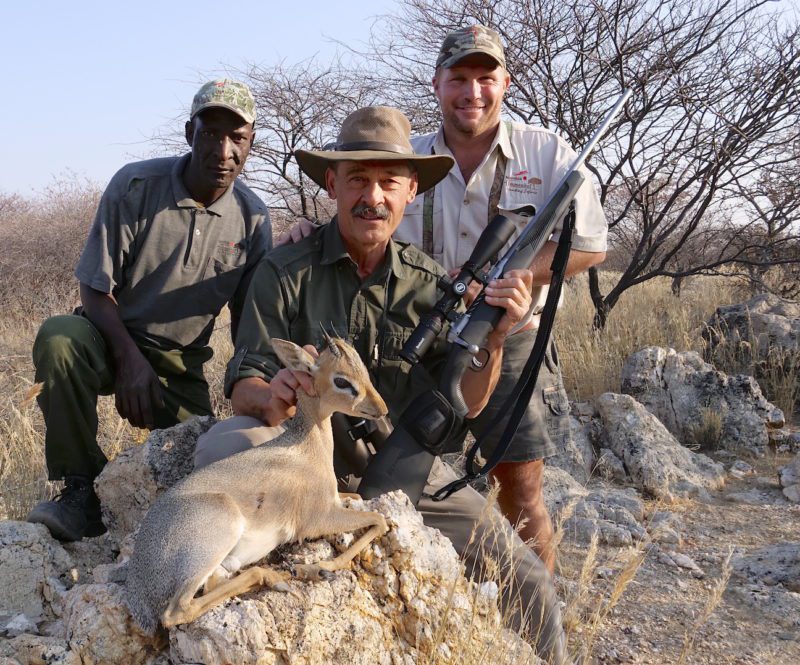
A dik dik ram is one of the reasons I carried a Savage AccuFit rifle in 223 Remington to Namibia. Tracker Jerrod and PH Werner backed me up on this hunt. Back at the farm butchery, this ram weighed 11 pounds. Not quite as much as Betsy’s eland, but just as delicious. I zeroed with Bushnell’s new 2.5-10X NITRO scope. The black wrap on the butt stock is a Stratus support that clips to a holder on my belt. Takes the weight off my shoulder during long hikes. As usual, I’m using a Butler Creek Quick Carry sling that adjusts length quickly for use as a hasty sling for steadying shots.
Our shared AccuFit 223 Remington has also racked up a scrub hare, dassie, and jackal. The 30-06 Savage Storm has also brought down an old oryx bull. The hunt continues with kudu, red hartebeest, steinbok, warthog, and more on the list.
Ron is a Senior Editor at Sporting Classics.
Ron and Betsy contracted safari fever more than 20 years ago and return to Africa often to cool it. Immenhof Hunting Safaris is one of their favorite outfitters.

